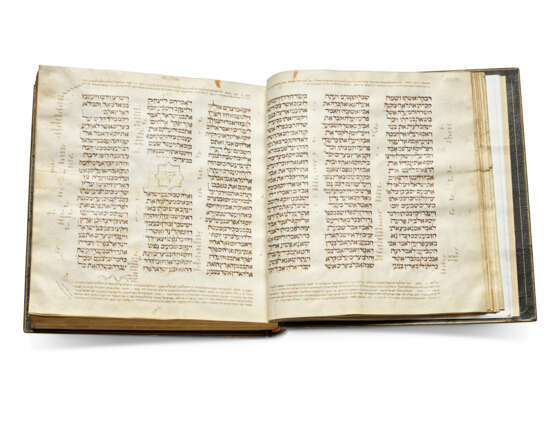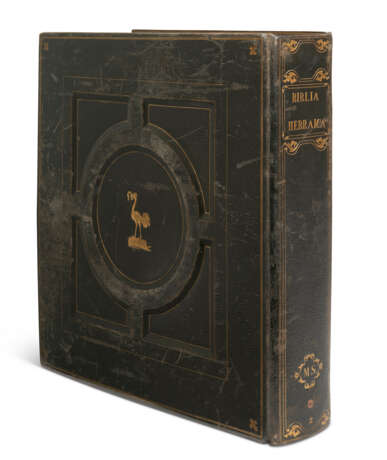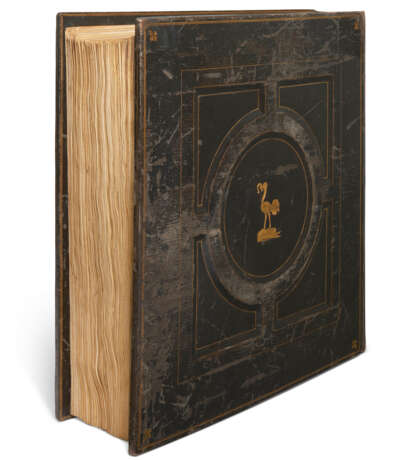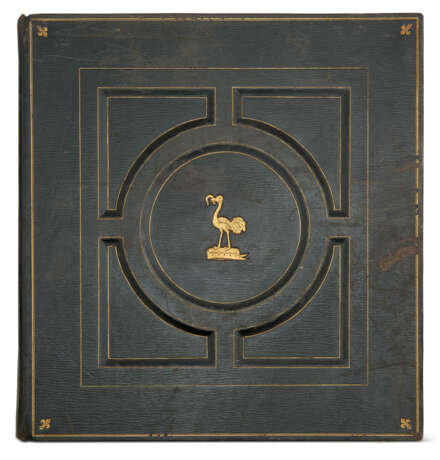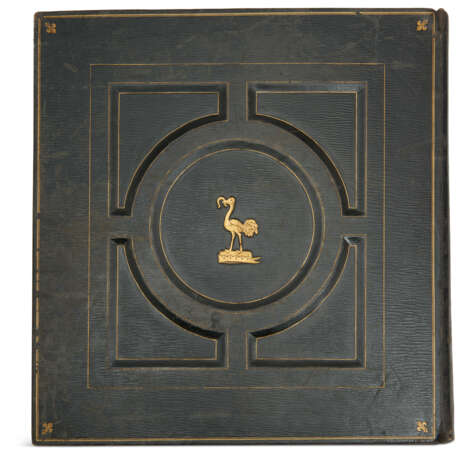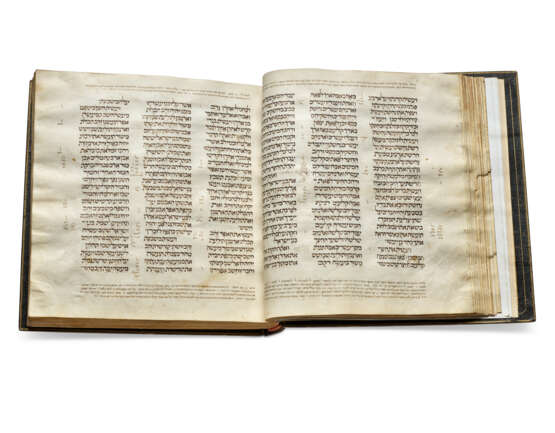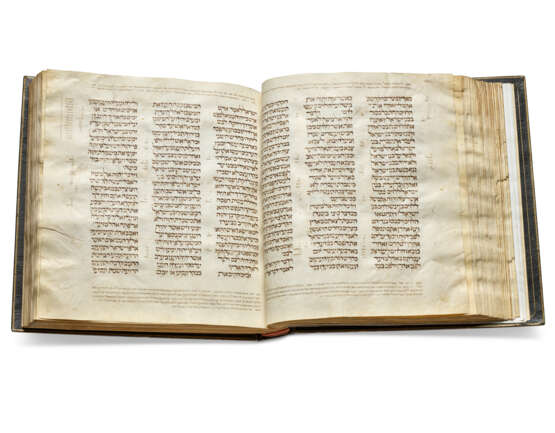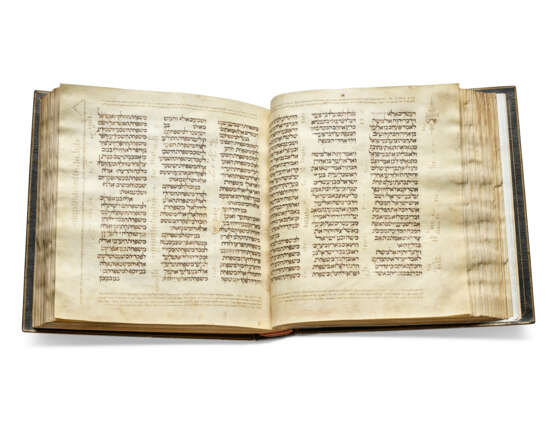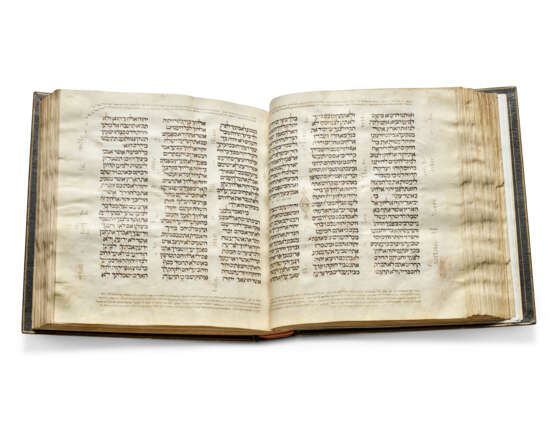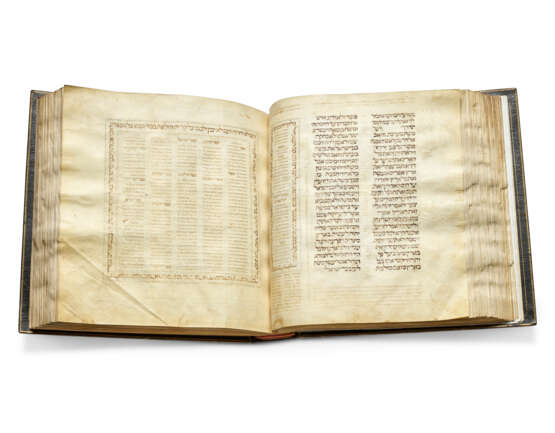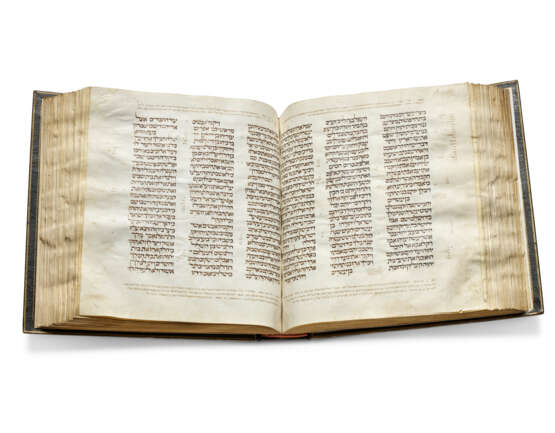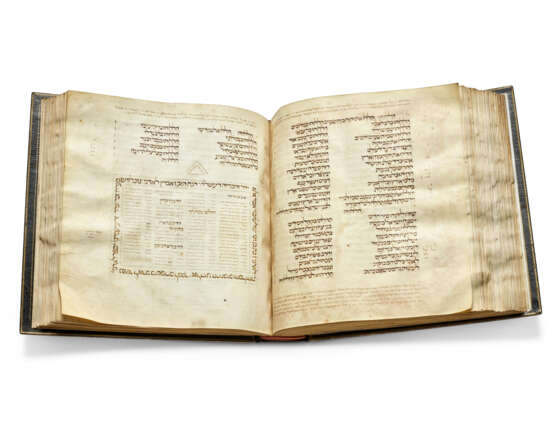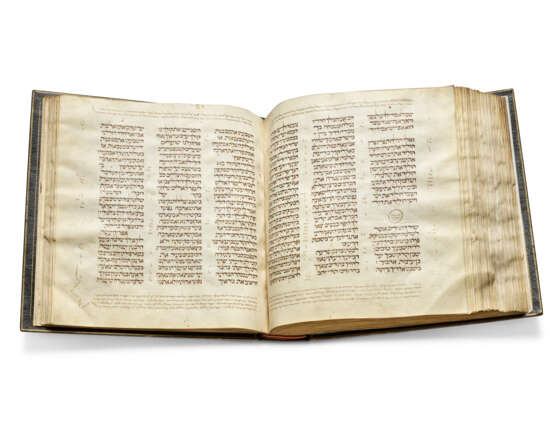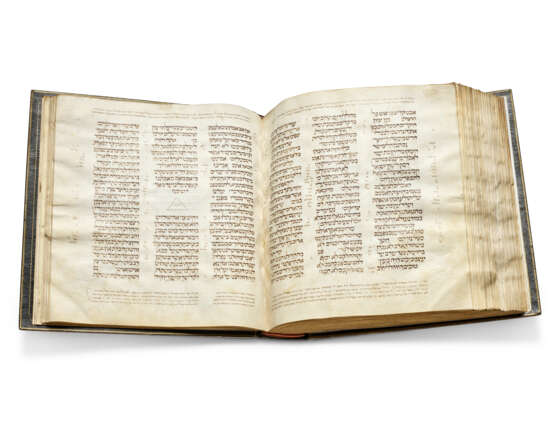ID 1214868
Lot 14 | The Holkham Hebrew Bible
Valeur estimée
£ 1 500 000 – 3 000 000
Pentateuch and Hagiographa, in Hebrew, with vocalisation, accentuation, Masora parva and Masora magna, decorated manuscript on vellum [Toledo, 2nd quarter 13th century]
'One of the most splendid Sephardic Codices': the large-format 'Holkham Hebrew Bible', of exceptional calligraphic quality, produced in Toledo in the second quarter of the 13th century; one of the earliest additions to the the famous collections of Thomas Coke and Holkham Hall.
360 x 340mm. 264 leaves, 34 gatherings comprising the Pentateuch and the Hagiographa, the vellum of Sephardi type, 24 lines in two or three columns per page, according to the biblical book, the biblical text written by one scribe in a calligraphic square script of the Iberian-Sephardi type containing full Tiberian vocalisation and signs of cantillation, careful Masora parva and Masora magna notes in a simplified 'masoretic' square Sephardic script by two hands, additional Masoretic lists and inscriptions written in the spaces between biblical books, the ruled space of the main biblical text: c.255 x 250mm, blank spaces to separate between the biblical books, each book ending with a decorative inscription giving the number of verses (the surviving gatherings internally complete, at least 2 gatherings lacking at the beginning, the end missing, other lacunae within the volume include one gathering between ff.88-89; one gathering between ff.96-97; one gathering between ff.144-145, with most of Genesis, about half of Deuteronomy, the end of Chronicles, the beginning of Psalms, the end of Ezra, and Nehemiah, a few smudges, occasional fading of text, but generally in exceptional condition). Binding of blue-black morocco gilt over wooden boards, central panel with ostrich, crest of Thomas William Coke, bound by Jones, Liverpool, 1820 (a little scuffed).
Provenance:
(1) According to Prof. Judith Olszowy-Schlanger, the manuscript is securely localisable to Toledo and datable to the second quarter of the 13th century. The scribe of the main text and probably also Masorete 1 is identifiable as Israel ha-Sofer ben Isaac ben Israel (see below).
(2) Thomas Coke (1697-1759), 1st Earl of Leicester and builder of Holkham Hall in Norfolk, renowned collector and connoisseur: his bookplate, type A, on pastedown of upper board. The manuscript was once MS 2 in the Library, among the earliest acquisitions by Coke and very likely the same Hebrew Bible that was purchased with the Codex Leicester of Leonardo da Vinci, a scientific notebook that would become, when sold by Christie's in 1994, the most expensive book or manuscript ever sold at auction, fetching $30,802,500. They are both described in the Account book of payments made by Casey for Thomas Coke, 1718-1720 (now Holkham Hall Archive A/5, p. 67) as follows: '1719 May 21st. Paid to Mr. [Andrew Hay] for bringing Pictures from A Broad, Lining, mending & Straining ye same Carriage Duties at the Custome House. A Hebrew Bible, A Manuscript of Lionardo [sic] da Vinci etc. [£] 26.05.00'.
Holkham MS 2 was described for the first time by Benjamin Kennicott (his Codex 682), who dated it to the late 14th century (Kennicott, [1776]-1780, p.109): 'Pentat. Hagiog. MS. Biblioth. Holkhamens.. Deficit ad Gen. xxxix.22, Psal. ad V.12, Ezra ad VI.2, II Chron. a xxix.12. Chron. praecedunt Psal, Job, Prov., Ruth, Cant. et Eccles. Threnos. Scriptus est Hispanice, et in libris 3 poeticis hemistice. Forsan exeunte sec. XIV'. It was subsequently published with a more detailed description in Brun's 1783 edition of Kennicott's Dissertatio generalis as follows: 'Cod. Hispan. fol. min. oblongo; columnis tripartitis, cup Masora copiosissima, nitide et perspicue conscripta, quae cum editis conferri meretur [...]' (see Kennicott, 1783, pp.529-530). Giovanni Bernardo De Rossi correctly dated it to the 13th century in 1784 (De Rossi, 1784, p.94). These descriptions were cited both by William Roscoe (Roscoe, 1834) and verbatim by Sir Frederic Madden in his autograph catalogue of the manuscripts at Holkham Hall.
As with almost all the Holkham manuscripts, the present volume was disbound, likely upon acquisition, and rebound only during the 1815-1823 rebinding campaign initiated by Thomas William Coke under the direction of William Roscoe and the Liverpool binder John Jones. The blue-black morocco binding was finished around the 10 May 1820 and is described as follows in Jones' Account Book (Holkham MS. 748, f.22): 'Biblia Hebraica. MS. large, Oblong folio, Bound in Black Morocco [£] 4.14.6'.
At the end of the 19th century the manuscript was lent by Lord Leicester to Professor Christian D. Ginsburg in order that it might feature as no 51 in his Introduction to the Massoretico-critical edition of the Hebrew Bible. Ginsburg described it as 'one of the most splendid Sephardic Codices' (Ginsburg, 1897, p.728): his manuscript notes are bound in at the beginning of the codex, written sometime after 1880 (the publication date of vol. 1 of his Massorah, mentioned in the handwritten pages, p.1), and before 1885, the publication of vol. 3 of his Massorah.
Holkham Hall remains today the largest and finest manuscript collection in private ownership in the United Kingdom. The manuscript was acquired directly from Holkham Hall in 2002 by:
(3) The Schøyen Collection, MS 5070.
Content:
Pentateuch, beginning with Genesis 39:22b-Deuteronomy 34:12 (lacking Genesis 1:1-39:22a; Numbers 31:12b-Deuteronomy 4:13b; 13:18-26:15b), ff.1-104v; a decorative panel and a poem praising the accuracy of the manuscript f.104v; genealogies framed within decorative panels ff.104v-105; Hagiographa: 1 Chronicles-2 Chronicles 29:12 (lacking 29:12b-36:23); Psalms 5:12-150:6 (lacking Psalms 1:1-5:11); Job, Proverbs, Five Megillot, Daniel, Ezra 1:1-6:9 (lacking Ezra 6:9b-10:44; Nehemiah), ff.105v-264v.
Page and text layout:
The volume contains two out of three main subdivisions of the text of the Hebrew Bible: the Pentateuch (Torah) and the Hagiographa (Ketuvim). The middle section, the eight books of the Prophets (Nevi’im), was never a part of this codicological unit. Indeed, after the end of the Torah on f.104v, there is a biblical chronology (genealogies), framed within a decorative panel. The genealogies included within the panel on f.104v end with Leviticus. The genealogy follows directly with 'Book Four' (Numbers) and 'Book Five' (Deuteronomy) on the next page, f.105. This second part of the chronology is written on the full page with a decorative inscribed panel around it. Folio 105v begins with 1 Chronicles 1:1, which opens the Hagiographa section. This textual continuity of the biblical chronology excludes the possibility of the presence of the Prophets’ section in this volume, even if the chronology itself covers the books of the Prophets as well as Chronicles and Ezra-Nehemiah – the latter two belonging to the Hagiographa portion.
The narrative parts of the volume are laid out in three columns per page, each c.65-70mm wide and 255mm high. In accordance with the scribal tradition, the poetic parts within the narration have specific ‘song’ layouts, as defined by the Talmud: the Jerusalem Talmud (Megillah 3:7, 74b) and the Babylonian Talmud (Megillah 16b) determine that one must write certain songs in the Bible in a specific layout. In particular, the Song of the Sea (Exodus 15) and the Song of Deborah (Judges 15) have to be written in a 'brick pattern', ’ariah 'al gabei leveinah, every two lines (excluding the opening line) in the following manner: the first line in 3 parts, the second line in 2 parts, with the texts of the second line beginning and ending the line, and also lining up with the empty spaces of the first line. On the other hand, the kings of Canaan (Joshua 12) and the sons of Haman (Esther 9) are to be written ’ariah 'al gabei ’ariah uleveinah 'al gabei leveinah, essentially two columns of text separated by a space, with the repeating word(s) lined up in a column, one word under the next. These latter two cases are essentially not Songs, but rather lists with repetitive texts. The later work, Massekhet Soferim (Higger ed.; 1:11; 12:7, 8), also determined how to write the Song of Moses (Deuteronomy 32).
Thus, the Song of the Sea (Exodus 15) (two facing folios, 20v-21, in the middle of the quire) is laid out in a specific pattern of alternating blocks of text and blank spaces known as ‘a half brick over a whole brick’ (’ariah ‛al gabei leveinah). The whole 'complex' of the lines before and after the Song and the Song itself, all add up to 42 lines, which comprises one column in a Torah scroll with 42 lines to the column. In our manuscript the whole 'complex' was laid out over 2 pages, and taken together these 2 pages reflect one column in a 42-line Torah scroll. The Song of Moses (Deuteronomy 32, 1-52), on ff.102-103v, is written according to the pattern of ‘a half brick over a half brick and a whole brick over a whole brick', creating two narrow columns of written text on two extremities of the line, separated by a ‘chimney’ of a blank space. The Song is written in 67 lines as in the Aleppo Codex (and not in 70 lines, another popular format). In addition, the Masorete added a long note (f.102, in between the columns) concerning the layout of the Song itself. This note is quite old, apparently originating with Sefer Tagei, a scribal-mystical work from the Geonic period (mentioned in the 10th century but probably redacted earlier). The long note points out that the Song should be divided into three parts: in the first part (vv.1-14), the beginning of the verses start at the beginning of the line (i.e., in the right column); in the second part (vv.15-39), the beginning of the verses start in the middle of the line (i.e., at the beginning of the left column); in the third part (vv.40-43), the Song resumes the former format, beginning of the verses at the beginning of the line (i.e., at the beginning of the right column). A similar arrangement is found in the text of the Ten Commandments (f.24v), a passage in Kohelet (f.237) and the list of the sons of Haman in the book of Esther (9:7-10) (f.249). The poetic texts of the book of Psalms, Proverbs and Job (except for its narrative beginning and end, written as one block of the running text) are written in two columns per page, each line subdivided by a blank space within the line into two unequal hemistichs.
The two large parts of the Bible, the Pentateuch and the Hagiographa are followed and, at least in the case of the Hagiographa (the beginning of the Pentateuch is missing) preceded by texts on biblical chronology and masoretic texts, written in a decorative framework. The initial words of the biblical books are not differentiated, their size and style correspond to the rest of the text. There is however a blank space of three or four lines to separate between the biblical books. Each book ends a decorative inscription giving the number of verses it contains. The inscriptions also contain masoretic material and are often displayed in geometrical shapes.
The text of the Pentateuch is subdivided into pericopes (parashot) corresponding to the weekly reading of the Torah scroll in the liturgy in a one-year cycle as well as in sedarim, shorter portions of such readings following a three-year cycle (a liturgical custom of the Jews of the Land of Israel in late antiquity and the early Middle Ages). The beginning of a new parashah is indicated by the abbreviation פרש in the corresponding margin, usually with intricate penwork geometrical interlaces and vegetal motives decoration. Sedarim are marked by a letter samekh with more modest floral ornaments. The presence of the sedarim subdivisions is relevant for the manuscript’s origin.
The sections are subdivided into paragraphs/sections marked by the blank spaces in the line. The correct placing of the parashot petuhot and parashot setumot (open and closed sections – an open section is marked by a blank space running until the end of the line whereas a close paragraph is a blank space enclosed by the text) is a matter of scribal traditions that vary in different communities. It is interesting to note that the open and closed paragraphs in the Pentateuch in our manuscript agree almost completely with the list of such paragraphs drawn up with Moses Maimonides in his Mishneh Torah (Hilkhot Sefer Torah 8:4). Maimonides followed a 'codex famous in Egypt', which scholars identify today with the Aleppo Codex (MS Ben Zvi 1), despite the fact that almost all of the Aleppo Codex’s Pentateuch is lost (see J.S. Penkower, 'Maimonides and the Aleppo Codex', Textus, vol. 9, no 1 (1981) and 'New Evidence for the Pentateuch Text in the Aleppo Codex', Sources and Studies, 6, 1992).
The masoretic tradition:
The critical apparatus of the Holkham Hebrew Bible follows a careful masoretic tradition. Masora parva is placed in lateral margins. Masora magna (MM) occupies the upper and lower margins. MM is written over the width of all three columns of text, both in the top and in the bottom margins. The one exception being on f.104v, the folio that contains the end of Deuteronomy in the first two columns, and reserves the third column for masoretic materials. On this page, the Masorete wrote MM both in the top and bottom margins, over the width of the first two columns only. The masoretic critical notes contain the marginal collation of the text with the other masoretic model exemplars: the Codex Mugah (literally 'the Proofread') and the Codex Hilleli. Nine references to Hilleli in the Holkham Hebrew Bible are: Genesis 42:16 (ורסאֵה), Genesis 47:30 (השְעא), Leviticus 13:57 (י ִתְשַב), Deuteronomy 12:11 ( ורְּד ִּת ), Job 40:4(י ִתלק), Song 4:5 (םירפֳע), Song 7:4 (םירפֳע), Daniel 3:15 (ןַעְכ), Daniel 10:6 (ה"פל תחתמ אתחנתא ,ידיפלכ). These nine notes can be compared to the list in Ginsburg’s Massorah, vol. 3, pp.130-134: 'The variants between Hilleli and Mugah.' The note in Deuteronomy reads in our manuscript: 'I have seen in the Hilleli […]', which implies that the Masorete saw the actual Hilleli manuscript, and didn’t simply copy a note from another manuscript. The notes of the masoretic critical apparatus also contain lists of variants between two famous masoretic schools of the 10th-century Orient, the Ben Asher and Ben Naphtali schools, as well as the variants of the even more ancient Oriental masoretic traditions of the Medinha’i (East) and Maarva’ei (West), and the variant readings of the tradition of Sura and Naharea in Iraq (for full details, apply to department for Prof. J.S. Penkower's report). The scribe of our manuscripts also carefully followed the specific scribal practices used not only in the codices but primarily in the liturgical scroll, such as the enlarged letters in specific place of the text of the Pentateuch, inverted nuns or suspended dots. He took special care not to desecrate the holy name of God: when the tetragrammaton was written by mistake, it was not erased but rather marked out by a series of lines.
Script type:
To define the type and sub-type of the script with precision is essential to locate and date this manuscript devoid of a colophon.
The main script is a calligraphic square Sephardi. Its salient features include a great regularity of the letter shapes, with the upper horizontal lines parallel to the headline, bases parallel to the baseline, vertical downstrokes perpendicular to both. There is a high degree of parallelism between strokes. The letters are large, the average he measuring c.5 x 4.5mm, and shin 5 x 5mm, giving the script regular proportions and rhythm. The letters without ascenders and descenders respect the headline and baseline, except for the letter ‘ayin which is long, descends below the baseline and often underlines the following letter creating a typical Maghrebi-Sephardi nesting effect. The shapes are pure, with very small approach strokes rather than prominent serifs on the horizontal bars. The letters are traced with a calamus, whose Maghrebi-Sephardi way of reed cutting accounts for the soft finishing of the lines, gracefully thinning descenders of the final forms of the letters and well as thinning extremities of the bases which often descend very slightly below the baseline. The characteristic morphological features of the letters include aleph whose left-hand downstroke is a ‘knee’ thickening towards the foot, and the foot turns towards the left; a long gimel, whose left-hand downstroke meets the stem with an angular juncture at the baseline and is parallel to the baseline, an almost closed mem (very narrow space between the base and the left-hand downstroke); and shin whose right arm created a thick base almost parallel to the baseline. The ascender of the lamed is characteristically short, equal or shorter than the body of the letter included within the line of writing, in the scribe’s calligraphic effort not to impede on the line above. This is different when lamed is the last letter of the line: it then may climb for the length of two lines or more alongside the column. As a typical Sephardi lamed, its ascender is slightly curved to the right, short in the context of the line, thin on the top and thick at the base, at the level of the horizontal stroke, and ended on the top by a tiny flag placed slightly to the left.
While the characteristics can be attributed to most calligraphic Sephardi manuscripts in square script between the late 12th and the 15th centuries, the palaeographical comparison with the dated Sephardi samples allows us to pinpoint a more specific sub-type of the Sephardi calligraphic square attested in the Holkham manuscript. The presence of such features as shading (the difference between strokes traced with the full width of the nib and with its edge is particularly evident in the arms of the letter ‘ayin, the right and middle arms of the shin, the downstroke of lamed and the left-hand downstroke of mem), and the rounded top of the letter mem excludes the date before the 13th century. The square proportions of the letters, and their slightly wavy, soft strokes suggest a date in the 13th century. The first preliminary examination pointed towards Toledo as a possible place of copy. To verify this hypothesis, Prof. Judith Olszowy-Schlanger compared the manuscript with a corpus of dated and localised manuscripts from Toledo or ascribed to Toledo in scholarship, namely: Oxford, Bodleian Library Kennicott 7, Prophets, 1222, Toledo; New York, Jewish Theological Seminary 401-403 (olim L 44a), Pentateuch, 1241, Toledo; Parma, Biblioteca Palatina, Parm. 2025, 1256, Toledo; Parma, Biblioteca Palatina, Parm. 2668, 1277, Toledo; Paris, BNF hébreu 26, 1272, Toledo; Paris, BNF hébreu 25, 1233, sine loco; Jerusalem, NLI 4° 1112, c. 1250, sine loco.
In all these manuscripts, Prof. Olszowy-Schlanger found similar stylistic features at the level of the calligraphic script, graphic symbols and decoration. In most of the corpus, she found an unusual shape of the sof pasuq punctuation signs.
One of the salient features of the manuscript is the presence of a masoretic proofreading colophon, placed after the end of Deuteronomy. In addition to our manuscript, this poem, with some variants, appears in another nine Sephardi masoretic codices, from the 13th and 14th centuries (in the years 1232-1383), with one additional manuscript from 1496. In the eight manuscripts from the 13th and 14th centuries the poem is written in a large font and occupies a full page, usually framed with other masoretic material. The poem appears almost always prior to the text of Genesis (in one manuscript, Jerusalem, NLI 40 1112, it appears at the end of the manuscript). In the latest manuscript with the poem (1496; Rome, Library of the Jewish Community [2]), it now appears in a large font as part of the outside frame surrounding other masoretic material at the end of the manuscript. Given that in our manuscript the poem follows the end of Deuteronomy and is written almost as an afterthought, one can conclude that our Masorete was not the author of the poem but copied it from another manuscript. Nevertheless, the poem correctly reflects the accuracy of our manuscript with respect to the text, section divisions, and layout of the Songs in the Pentateuch.
Most importantly for our purpose, this masoretic ‘proofreading’ colophon, almost identical from one manuscript to another, is attested in all the above manuscripts located or related to Toledo. Like our manuscript, this Toledan group also contains masoretic compositions and lists placed in a decorative frame created by a line of display-size inscriptions. This text does not contain any historical information about the manuscript’s Sitz-im-Leben; it is nonetheless characteristic for manuscripts from Toledo.
Handwriting:
The consonantal text of the manuscript was written by one scribe. His work is of a high calligraphic quality. The masoretic notes are by two different hands. Masorete 1 was likely identical to the scribe of the consonantal text. He added all masoretic notes in the Pentateuch part. A different ink colour confirms that he works in two stages, adding the vowels and the masoretic notes after he wrote the consonantal text. In the Hagiographa, two masoretic hands can be distinguished: our Masorete 1 and Masorete 2 who worked in collaboration with Masorete 1. Masorete 1 seems to have worked on f.118-120v; 122v-144v, while Masorete 2 worked on f.105-117v, 121r-v, 145-end of the volume. All the decorative panels, even in the parts of Masorete 2, were written by Masorete 1.
There is a close affinity between our manuscript and New York, Jewish Theological Seminary 401-403 (olim L 44a), a Pentateuch, dated by its colophon to 1241 and written in Toledo. The handwriting of the main text seems to be the work of the same person. The characteristic features include pe with a short upper horizontal bar traced with the same movements as the right-hand downstroke, whose nose is very large, wavy (especially in the final pe, in which it almost reaches the baseline) and attached to the left-hand extremity of the upper horizontal bar and extended upwards by an additional serif. Shin appears with strong shading, with very thin right and middle arms. The Masora of JTS 401-403 is written by the Masorete 1 of the Holkham Pentateuch (who is probably identical to the main scribe). Although the manuscripts differ in the size and page layout (JTS 401-403 is written in two columns per page), they display similar treatment of the left-hand margin: the margin is not perfectly justified, but there are extended letters as well as squeezed words; the scribe does not use graphic fillers. Both manuscripts contain similar marks of the parashah in penwork interlace and knotwork pattern framing the abbreviation pe, resh and truncated shin (for parashah). Both manuscripts enhance the samekh of seder with a floral penwork outline. The space between two biblical books contains inscriptions (number of verses in the book) in micrographic geometrical shapes of similar design in both books (circles, triangles, eight-branch stars). Both manuscripts contain a characteristic shape of sof pasuq: two vertical short diamond-shaped strokes linked together and sometimes resembling a tiny letter zayin (this unusual shape appears however in several other manuscripts from the Toledo group, especially those of the first half of the 13th century). It is also relevant that the division of the Pentateuch into sedarim in addition of the pericopes of the annual reading cycle, frequent in the early Oriental codices, in Spain has been observed in particular for manuscripts from Castille, and in particular for Toledo and Burgos.
JTS 401-403 was written, vocalised and provided with the Masora by a professional scribe and Masorete Israel ha-Sofer ben Isaac ben Israel for a patron Abraham ben Solomon ben Abudraham in Toledo in 1241 (the same scribe also copied Oxford, Bodleian MS Kennicott 7). Its colophon specifies that it was copied from a proofread model called ‘Hilleli’. As we saw, the reference to Codex Hilleli – a famous corrected exemplar of the Bible now lost but mentioned in a number of Castillian manuscripts, is also found in the Holkham Hebrew Bible. The manuscript also contains a masoretic proofreading poem, very similar to the one in MS Holkham (f.104v, end of the Pentateuch) and the other manuscripts of the Toledo group, praising the textual version of this Bible manuscript and its correctness while allowing us to attribute these manuscripts to the same scribal school.
This close similarity of the scribe and Masorete 1 of the Holkham Hebrew Bible and of JTS 401-403 allows us to propose a date for MS Holkham in the second quarter of the 13th century and to situate its production in Toledo.
We are grateful to Professor Judith Olszowy-Schlanger, Director of the Centre for Hebrew and Jewish Studies; President of the Oxford Centre for Hebrew and Jewish Studies; Fellow of Corpus Christi College for her codicological and palaeographical analysis and to Professor Jordan S. Penkower, Dept. of Bible, Bar-Ilan University, for his report on the Masora and textual transmission. Both reports are available on request.
Literature
De Rossi, G.B., Variae Lectiones Veteris Testamenti, Parma, 1784, p. 94.
Ginsburg, G., Introduction to the Massoretico-critical edition of the Hebrew Bible, 1897, pp.728-734, no 51.
Kennicott, B., Vetus Testamentum Hebraicum: cum variis lectionibus ex codicibus manuscriptis et impressis, [1776]-1780, II, 'Dissertio generalis in Vetum Testamentum Hebraicum', p.109, Codex 682.
Kennicott, B., Dissertatio generalis, 1783, pp.529-530, Codex 682.
Roscoe, W., 'Account of the Manuscript Library at Holkham in Norfolk, belonging to T. W. Coke, Esq. by W. Roscoe, Esq. [...].Transactions of the Royal Society of Literature, vol. 2, part 2, 1834, pp.352-279.
Sed-Rajna, G., 'Toledo or Burgos?', Journal of Jewish Art 2 (1975), p.7.
| Lieu d'origine: | Europe, Espagne |
|---|---|
| Catégorie maison de vente aux enchères: | Manuscrits médiévaux et de la Renaissance, Livres et manuscrits |
| Lieu d'origine: | Europe, Espagne |
|---|---|
| Catégorie maison de vente aux enchères: | Manuscrits médiévaux et de la Renaissance, Livres et manuscrits |
| Adresse de l'enchère |
CHRISTIE'S 8 King Street, St. James's SW1Y 6QT London Royaume-Uni | |
|---|---|---|
| Aperçu |
| |
| Téléphone | +44 (0)20 7839 9060 | |
| Commission | see on Website | |
| Conditions d'utilisation | Conditions d'utilisation |
